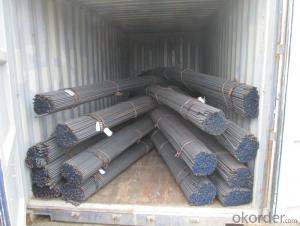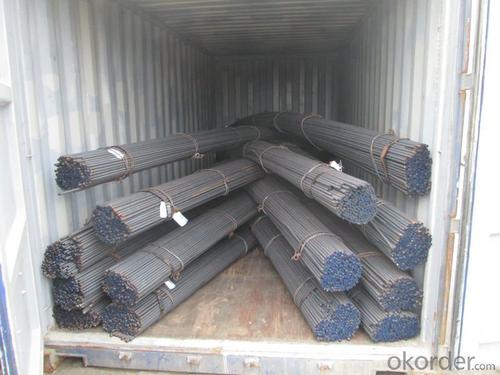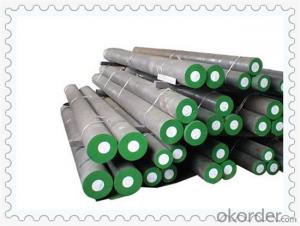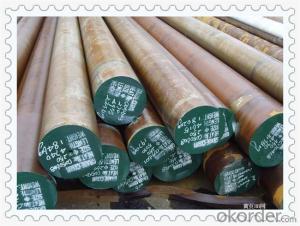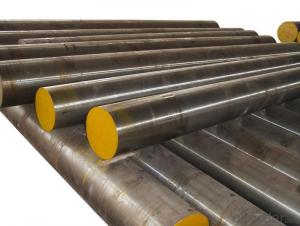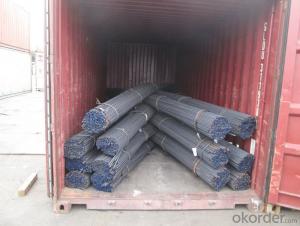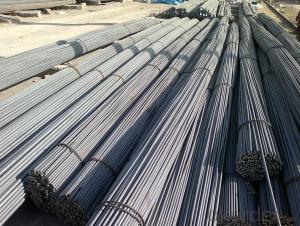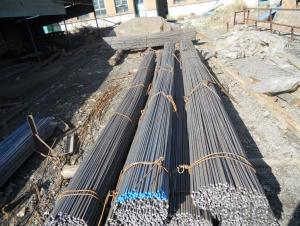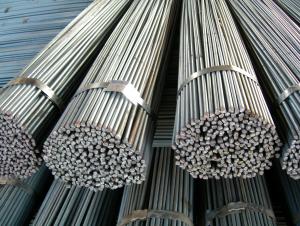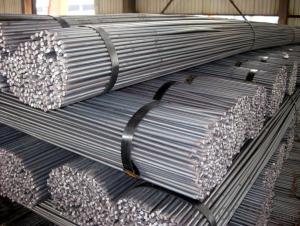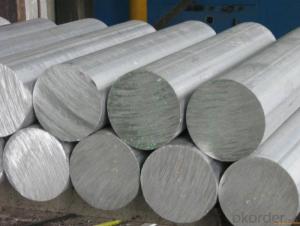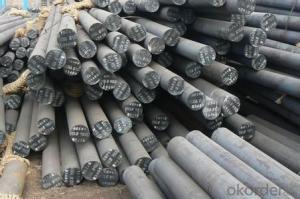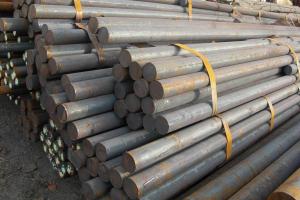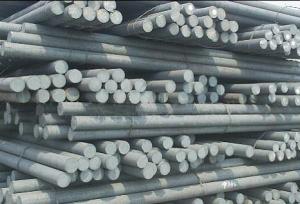Steel Round Bar with Grade Q195/Q235 and High Quality
- Loading Port:
- China main port
- Payment Terms:
- TT OR LC
- Min Order Qty:
- 100 m.t.
- Supply Capability:
- 2000 m.t./month
OKorder Service Pledge
OKorder Financial Service
You Might Also Like
Specification
Product Description:
OKorder is offering Steel Round Bar with Grade Q195/Q235 and High Quality at great prices with worldwide shipping. Our supplier is a world-class manufacturer of steel, with our products utilized the world over. OKorder annually supplies products to European, North American and Asian markets. We provide quotations within 24 hours of receiving an inquiry and guarantee competitive prices.
Product Applications:
Steel Round Bar with Grade Q195/Q235 and High Quality are ideal for structural applications and are widely used in the construction of buildings and bridges, and the manufacturing, petrochemical, and transportation industries.
Product Advantages:
OKorder's Steel Round Bar with Grade Q195/Q235 and High Quality are durable, strong, and resist corrosion.
Main Product Features:
· Premium quality
· Prompt delivery & seaworthy packing (30 days after receiving deposit)
· Corrosion resistance
· Can be recycled and reused
· Mill test certification
· Professional Service
· Competitive pricing
Packaging Details:
Products are packed in bundle and then shipped by container or bulk vessel, deformed bar is usually naked strapping delivery, when storing, please pay attention to moisture proof. The performance of rust will produce adverse effect.
Each bundle weight: 2-3MT, or as required
Payment term: TT or L/C
Delivery Detail: within 45 days after received advanced payment or LC.
Label: to be specified by customer, generally, each bundle has 1-2 labels
Trade terms: FOB, CFR, CIF
FAQ:
Q1: How do we guarantee the quality of our products?
A1: We have established an advanced quality management system which conducts strict quality tests at every step, from raw materials to the final product. At the same time, we provide extensive follow-up service assurances as required.
Q2: How soon can we receive the product after purchase?
A2: Within three days of placing an order, we will begin production. The specific shipping date is dependent upon international and government factors, but is typically 7 to 10 workday.
Q3: Why buy Materials & Equipment from OKorder.com?
A3: All products offered byOKorder.com are carefully selected from China's most reliable manufacturing enterprises. Through its ISO certifications, OKorder.com adheres to the highest standards and a commitment to supply chain safety and customer satisfaction.
Images:

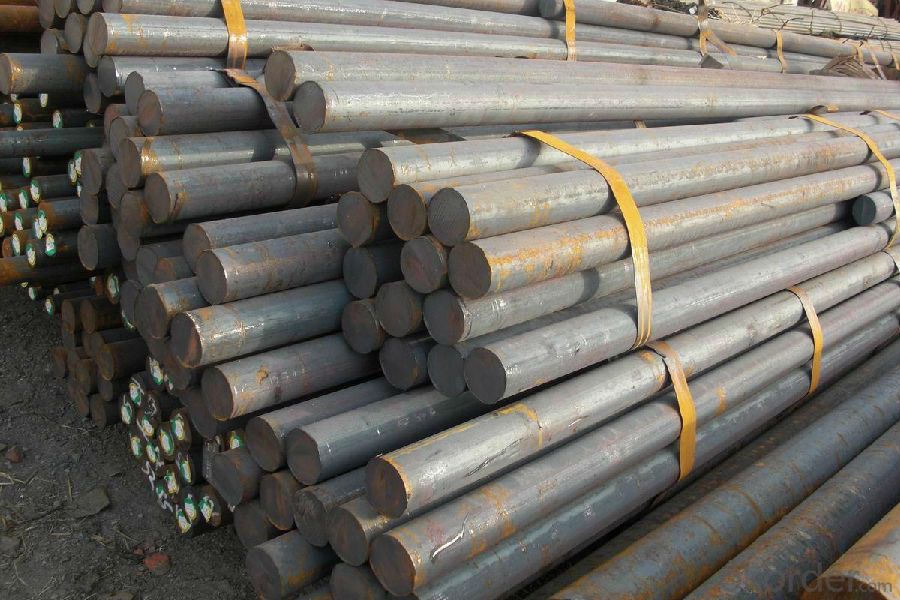
- Q: How do you measure the straightness of a steel round bar?
- To measure the straightness of a steel round bar, there are a few methods that can be used. One common method is to use a straight edge or ruler and place it along the length of the bar, checking for any gaps or deviations. If the bar is perfectly straight, it should be in contact with the straight edge along its entire length. Any gaps or deviations indicate that the bar is not perfectly straight. Another method is to use a laser alignment system. This involves placing the round bar on a flat surface and using a laser to project a line along its length. The laser will show any deviations or bends in the bar by the way the line is projected. This method provides a more accurate measurement of straightness. In addition, a precision measuring instrument called a dial indicator can be used. This device has a small probe that is placed against the surface of the round bar. As the bar is rotated, the dial indicator will measure any variations in the surface, indicating any bends or deviations from straightness. It is important to note that the level of straightness required will depend on the specific application of the steel round bar. In some cases, a minor deviation may be acceptable, while in others, a high degree of straightness may be necessary.
- Q: What is the difference between hot rolled and cold drawn steel round bars?
- Hot rolled steel round bars are produced by heating a steel billet or ingot at a high temperature and then rolling it into the desired shape. This process results in a rougher surface finish and a larger diameter tolerance compared to cold drawn steel round bars. Hot rolled bars are commonly used in applications where strength and durability are important, such as in construction and manufacturing. On the other hand, cold drawn steel round bars are produced by pulling a hot rolled bar through a die at room temperature, which results in a smoother surface finish and tighter diameter tolerances. This process also improves the mechanical properties of the steel, such as its strength and hardness. Cold drawn bars are often used in applications where precision and a high-quality surface finish are required, such as in the production of shafts, bolts, and precision components. In summary, the main differences between hot rolled and cold drawn steel round bars are the surface finish, diameter tolerance, and mechanical properties. Hot rolled bars have a rougher surface finish, larger diameter tolerances, and are typically used in applications where strength and durability are important. Cold drawn bars have a smoother surface finish, tighter diameter tolerances, and are commonly used in applications where precision and a high-quality surface finish are required.
- Q: Can steel round bars be used for making automotive chassis?
- Certainly, automotive chassis can be constructed using steel round bars. Due to its impressive strength and durability, steel is a prevalent material in the production of automotive chassis. The utilization of round bars made from steel ensures outstanding structural integrity, allowing them to endure the immense loads and forces that a vehicle's chassis encounters. Moreover, incorporating steel round bars in automotive chassis contributes to enhancing the overall safety of the vehicle by providing a robust and inflexible frame. Furthermore, steel is reasonably affordable and easily accessible, rendering it a favored selection for automotive manufacturers.
- Q: Are steel round bars available in different surface finishes?
- Yes, steel round bars are available in different surface finishes. Some common surface finishes include hot rolled, cold drawn, polished, and coated finishes.
- Q: Can steel round bars be hardened?
- Steel round bars can indeed be hardened through a specific procedure known as hardening. This procedure entails heating the steel to a precise temperature and swiftly cooling it, which is commonly referred to as quenching. The rapid cooling induces a transformation in the steel, leading to heightened hardness and strength. Typically, the hardening process is followed by tempering, which entails reheating the hardened steel to a lower temperature. This step serves to minimize brittleness and further enhance toughness. Hardening is extensively applied in the manufacturing of tools, machine parts, and various other applications that demand exceptional strength and durability.
- Q: Are steel round bars suitable for outdoor applications?
- Yes, steel round bars are often suitable for outdoor applications due to their high strength, durability, and resistance to weather conditions such as corrosion.
- Q: How do steel round bars compare to rubber round bars?
- Steel round bars and rubber round bars are distinct materials with contrasting properties and applications. Steel round bars, which are crafted from hardened carbon steel, are renowned for their robustness and resilience. With their high tensile strength, they can endure substantial loads and stress without distorting or fracturing. Construction, engineering, and manufacturing industries frequently employ steel round bars for structural support, reinforcement, and diverse mechanical purposes. Additionally, their exceptional resistance to heat and corrosion makes them suitable for extreme conditions. In contrast, rubber round bars, composed of synthetic or natural rubber compounds, possess exceptional advantages such as flexibility, elasticity, and vibration absorption properties. These attributes make them ideal for applications necessitating shock absorption, noise reduction, or effective sealing. Automotive industries, machinery mounts, conveyor systems, and various other industrial fields extensively employ rubber round bars to leverage their distinctive properties. While steel round bars excel in strength and rigidity, rubber round bars offer impressive flexibility and vibration dampening capabilities. The choice between steel and rubber round bars primarily hinges on the specific requisites of the application. When high strength and durability are necessary, steel round bars emerge as the optimal selection. Conversely, if flexibility, elasticity, or vibration absorption are prerequisites, rubber round bars prove more suitable. To summarize, steel round bars and rubber round bars exhibit contrasting properties and applications. Steel round bars grant strength and durability, whereas rubber round bars provide flexibility and vibration absorption properties. Opting for one over the other relies on the specific requirements of the application.
- Q: How are steel round bars used in the manufacturing of mining equipment?
- Steel round bars are commonly used in the manufacturing of mining equipment due to their high strength and durability. These bars are often utilized as a key structural component in the construction of heavy machinery such as crushers, drilling rigs, and conveyor systems. They provide the necessary support and stability required to withstand the harsh operating conditions and heavy loads typically encountered in mining operations. Additionally, steel round bars can be machined and shaped to create various components such as shafts, pins, and gears, further enhancing the functionality and reliability of mining equipment.
- Q: What are the different types of steel round bar alloys for improved machinability?
- There are several types of steel round bar alloys that are specifically designed to improve machinability. These alloys are chosen for their ability to be easily shaped, cut, and drilled, which is crucial in various machining applications. Some of the commonly used steel round bar alloys for improved machinability include: 1. 12L14 Steel: This alloy contains added lead, which enhances its machinability. The presence of lead lubricates the cutting tool, reduces friction, and improves chip formation during the machining process. 2. 1215 Steel: Similar to 12L14, 1215 steel also contains added lead, which provides excellent machinability. This alloy is known for its high cutting speeds, smooth surface finish, and improved chip control. 3. 4140 Steel: Although not specifically designed for machinability, 4140 steel is known for its excellent overall machining properties. With proper heat treatment, this alloy offers good strength, toughness, and wear resistance while still maintaining a reasonable level of machinability. 4. 1018 Steel: This low carbon steel alloy is widely used for its excellent machinability. It is easy to cut, drill, and shape, making it suitable for a variety of machining operations. However, it may have lower strength compared to some other alloys. 5. 8620 Steel: This alloy is specifically designed for case hardening, but it also offers good machinability. 8620 steel can be easily machined, providing high surface finish and dimensional accuracy. 6. 416 Stainless Steel: This stainless steel alloy provides good machinability due to its sulfur content. It is used in applications where corrosion resistance is required along with improved machinability. These are just a few examples of steel round bar alloys that are chosen for their enhanced machinability. The selection of the appropriate alloy depends on the specific machining requirements and the desired properties in the final product.
- Q: Can steel round bars be used in the manufacturing of tools?
- Yes, steel round bars can be used in the manufacturing of tools. Steel is a strong and durable material that can be easily shaped and manipulated into various tool designs, making it a popular choice in tool manufacturing. Additionally, steel's high tensile strength and resistance to corrosion make it ideal for tools that require strength and longevity.
Send your message to us
Steel Round Bar with Grade Q195/Q235 and High Quality
- Loading Port:
- China main port
- Payment Terms:
- TT OR LC
- Min Order Qty:
- 100 m.t.
- Supply Capability:
- 2000 m.t./month
OKorder Service Pledge
OKorder Financial Service
Similar products
Hot products
Hot Searches
Related keywords
